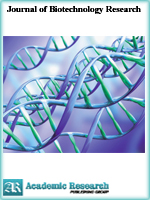Journal of Biotechnology Research
Online ISSN: 2413-3256
Print ISSN: 2413-8878
Print ISSN: 2413-8878
Quarterly Published (4 Issues Per Year)

Archives
Volume 2 Number 4 April 2016
Extraction of Biosurfactants Produced from Bacteria Isolated from Waste-Oil Contaminated Soil in Abakaliki Metropolis, Ebonyi State
Authors: Nwachi A.C. ; Onochie C.C. ; Iroha I.R. ; Agah V.M. ; Agumah B.N. ; Moses I.B. ; Oke Boniface ; Ogbeja D.O.
Pages: 24-30
Abstract
Biosurfactants are surface active compounds that reduce the surface and interfacial tension between two liquids or between a liquid and a solid. They are produced from a variety of microorganisms such as bacteria. This study focused on the extraction of the biosurfactants produced by bacteria isolated from waste oil contaminated soil. Four different waste oil-contaminated soil samples (Designated Samples A-D) were collected from mechanic sites and filling stations within Abakaliki metropolis, Ebonyi State, Nigeria and these were analyzed in the Microbiology Laboratory Unit of Ebonyi State University, Abakaliki using standard microbiological procedures. Twelve bacterial isolates were isolated from the waste oil-contaminated soil and were then tested for biosurfactant production using different techniques which included oil spreading test, emulsification test and blood haemolysis test. Out of the twelve bacterial isolates, six were found to produce biosurfactants. They were identified as Pseudomonas spp (4 strains), Bacillus sp and Staphylococcus spp. The Pseudomonas species were isolated from samples A, B, C and D, the Bacillus specie was from sample B and the Staphylococcus spp were from A and D. The result of their emulsification test showed that Pseudomonas b had the highest emulsification index (E), E24 in fuel (60.00%), followed by Pseudomonas a (50.00%). In kerosene, Pseudomonas a and Pseudomonas d had the highest E24 (47.50%), while in vegetable oil, Bacillus sp, Pseudomonas a and Pseudomonas b had the highest E24 (50.00%). Also, in paraffin oil, Pseudomonas a showed the highest E24 (71.43%) followed by Staphylococcus sp and Pseudomonas b (50.00%). The result of the oil spreading test showed that Pseudomonas d had the highest ODA (2.27cm2). This was followed by Pseudomonas and Pseudomonas c (1.77cm2) whereas Pseudomonas b had the least ODA (0.07cm2). Out of the six isolates, only three showed haemolytic activity (Pseudomonas b, d and Staphylococcus). The results showed that Pseudomonas represents a good candidate for the production of the biosurfactant when grown in both nutrient broth (NB) and mineral salt medium (MSM) supplemented with 2% glucose. The biosurfactants produced were extracted by centrifugation. Biosurfactant from Pseudomonas b had the highest weight (18.9g), followed by Pseudomonas a (18.8g) while that of Staphylococcus had the least weight (15.2g). The study was carried out on a small scale and if biosurfactant can be produced in large quantity, it can play an important role in the petroleum industry as well as in the bioremediation of oil-contaminated sites.



